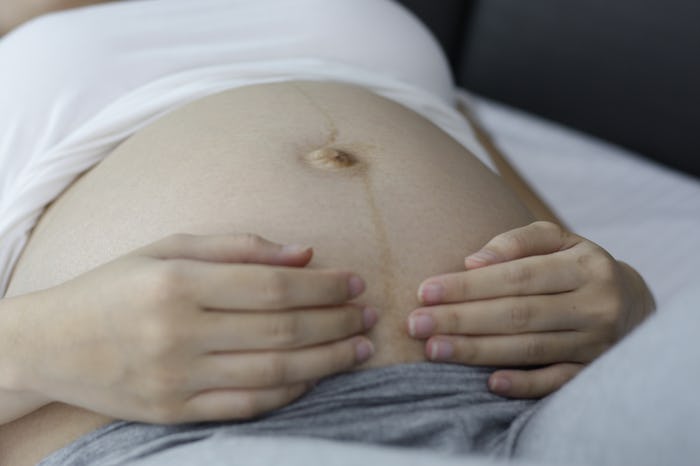Life

Here's Why Your Innie Belly Button Might Look *Way* Different During Pregnancy
During pregnancy, you will observe some significant changes to your body. Some of these changes you'll regard with awe, some with annoyance, and still others with varying degrees of concern. Falling under this category of common concerns is the question of what, exactly, happens to your belly button. After all, a brand spanking new human is growing right underneath your navel, causing all sorts of changes to the structure of your abdomen. So will your innie belly button “pop out" during pregnancy?
As it turns out, you shouldn't be surprised if your belly button pokes its head out of its burrow (so to speak), typically during the second or third trimester of your pregnancy, as this is not at all unusual for moms-to-be. Most of the time, you don’t need to be concerned when this happens (or doesn't). The Cleveland Clinic assures pregnant women that whether or not it pops out is not necessarily indicative of any sort of problem. Dr. Karmon James, OB-GYN writes, “If it happens to you, don’t worry. It in no way indicates a problem. And your belly button will probably return to normal after your pregnancy.”
So what, anatomically speaking, is the situation down there? I spoke with Dr. Linda Burke, a board-certified OB-GYN, and author of the book, The Smart Mother’s Guide to a Better Pregnancy, who explained exactly how your introverted belly button becomes an extrovert.
Dr. Burke says that during pregnancy, “The abdominal muscles stretch and beneath the abdominal muscles is a thin layer of tissue called the peritoneum. It looks like Saran Wrap and protects the contents in the abdomen and pelvis.” In fact, its Greek names literally means, “to stretch around.”
Outside the peritoneum are other protective tissues, as Dr. Burke describes: “There is also tissue called fascia. That covers the muscles. The umbilicus (AKA belly button) is where the fascia and peritoneum converge.” As you may know, when you were a developing fetus, your umbilical cord was the passageway through which nutrients were delivered to your body from your birth mother. After birth, the umbilical cord is cut, heals, and forms the belly button.
As for why your navel extrudes during the later stages of your pregnancy, Dr. Burke explains that “As the baby grows, the stretching and weakening of the muscles, peritoneum and fascia causes the belly button to evert or push out.” It’s sort of like how the valve in a beach ball will pop out once it reaches a certain point, however, unlike a beach ball, your stomach is not going to “pop” or “deflate.” In fact, the belly button popping out is a very normal and typically harmless characteristic of during pregnancy.
Should you ever be worried? Typically, the belly button poking out is normal and healthy. But uncommonly, there can be an underlying medical issue that needs attention. “This condition is not dangerous unless part of the intestines gets trapped in an umbilical hernia,” Dr. Burke explains. A hernia occurs when an organ or internal tissue pushes through the muscles or fascia. There are visual and physical cues that you may have an umbilical hernia: “If your popped-out belly button is painful or there seems to be a bulging mass alongside your belly button, see your doctor,” writes Dr. Karmon James.
But aside from this extremely unlikely case, your innie becoming an outie is a normal, painless occurrence, and one that is likely temporary.
This article was originally published on